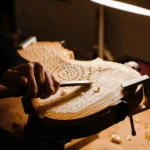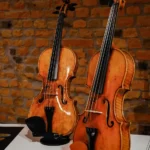How to Choose Your First Quality Violin: A Guide for Students and Parents
Back to BlogHow to Choose Your First Quality Violin: A Guide for Students and Parents
Since you’ve searched for this blog, it is evident that either your child is showing interest in learning to play the violin or has been enrolled in a music class where the teachers have requested that the parents buy quality instruments to assist the children in their musical journeys.
If you have zero knowledge regarding choosing a violin for your child, then stress not. The following blog will help you become aware of how to choose your first quality violin, telling you what you should keep in mind before closing the deal. It will serve as a good guide for both students and parents.
Stepping Forward To Buy Violin For Beginners
So, parents, we know you must be anxious to buy, and your children are excited to play with the musical device and can’t wait to perform in the school’s hosted musical shows. Before stepping forward to buy these string instruments, parents should keep a few things in mind, such as budget, which will be the biggest deciding factor, music shops that have multiple options of giving out the violin for sale and rent, the reputation of the maker who crafted the violin, the condition of it (new, pre-owned, or old), the materials that went into the creating the instrument itself, and so on.
On the other hand, children who will be playing the violin as students must remember to try the different models, set-ups, and sizes of the violin as there are several options to pick from; experiment with a couple of violins to notice how comfortable they feel, and hear the instrument at least in the shop’s premises to avoid later regrets.
Factors That Affect Choosing A Good Quality Violin
Now, we are moving ahead in discussing the factors that affect the choice of a good-quality violin. They are as follows:
Budget
Your child must have insisted you get them a violin for beginners to play in their school. You might have searched for violin prices but cannot compromise your child’s academics. Therefore, first check if your budget allows you to invest in a violin that matches your child’s requirements, as people will suggest you purchase premium quality violins that will help your child score more in the music class and give no chance to the teachers to complain that the violin is not upto the mark. Hence, plan your shopping according to your budget.
Buy Or Give It On Rent
If your student’s parents are having trouble finding the correct violin for their child’s age and tastes, you, as a teacher, can also help them by renting a beginner’s violin. Does this sound like a good idea? Go for it and assist them in this situation.
We believe that the right violin is a huge part of a musician’s development, and therefore, playing a high-quality instrument will help the student improve their playing skills. A musician’s abilities are enhanced when playing a quality instrument. Getting the right instrument is a challenge and involves playing. Therefore, before buying a quality instrument, it is more than necessary for the musician to try and play the instrument. So, in that way, to help more musicians and students have access to quality instruments, we have come up with the Rent to Own program.
Size Of The Violin
When searching for the best violin, pick the one or ask the salesperson to show you the violin that matches your child’s age, as the size of the violin matters. It is recommended never to buy or rent a musical device whose size does not align with the child’s age, especially for beginners. Why? The bigger violin will be a hassle for your child to handle, and they can end up with a significant back, neck, and arm injury that will end the charm of playing the violin for your child, as the wrong size means using the wrong technique to adjust the playing.
Therefore, it is essential to feel comfortable learning to play the violin, whether at school or home, and to accommodate that the correct size according to your child’s age is essential.
Every child has a different body and physical features, so measure the arm’s length to figure out what size of the violin can easily fit there, and ask for the teacher’s opinion and advice.
Materials That Were Used In The Making
While shopping for an article, the first thing anyone assesses is the material that it is made of. The same formula is applied to buying a violin as well. The blog emphasizes checking the wood material of the violin because it took three hundred years for the violin to be perfected. Since they are handmade, the craftsmen’s dedication, time, and efforts increase the instrument’s value and impact on making violins for beginners and students on the intermediate stage.
The raw materials usually used to make the ideal violin are maple and spruce. The spruce creates the top, while maple does the job on the sides and back of the violin. Ebony is used to form the pegs, chinrest, and fingerboard. Plywood rescues smaller violins and is used on the back, sides, and top. The violin might look like a piece of wood at first glance, but the quality of the wood affects the sound and price of the instrument.
What kind of hardwood went into the making of the fingerboard? Fingerboards are typically crafted out of ebony and dyed hardwood. The quality of the hardwood elevates its market value but gives better durability and tone. The dyed version falls under the cheaper category but loses its color and shape over time.
The violin’s better carving signals high-quality craftsmanship. This reveals that the maker knew their job and spent hours producing an instrument you will find irresistible.
Is The Violin Set Up Well?
This one is very important. See the violin set-up. Is it set up the way it should be or not? By set-up, we mean to check the curvature of the bridge, the curvature and concavity of the fingerboard, the turning of the pegs, and the fine tuners that should move without hard work. Steel strings are widely available, but it is highly recommendable to have strings made of synthetic core as the quality of sound takes the player to the next level and is very responsive. The height of the strings at the fingerboard also plays a unique role. They should be precise because if it is too high, it will become hard to play, and if it is too low, strings will not give the desired outcome.
Several factors, like the size of the violin, materials, and setup of the violin, matter when you choose to buy your first violin and expect it to be of good quality. Now, you can head over to Amorim Fine Violins, buy the correct violin, and amaze everyone with your violin-playing skills. By choosing from their exquisite selection, you’re not just buying a violin—you’re investing in a masterpiece that will elevate your child’s or student’s playing to new heights.









